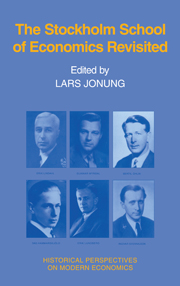Book contents
- Frontmatter
- Dedication
- Contents
- Preface
- List of Contributors
- Dramatis Personae at the end of 1937
- Introduction and Summary
- Part I The roots
- Part II The approach of the Stockholm School
- Part III The impact of the Stockholm School
- 15 The Swedish influence on Value and Capital
- 16 The London School of Economics and the Stockholm School in the 1930s
- 17 Thoughts on the Stockholm School and on Scandinavian economics
- 18 Ragnar Frisch and the Stockholm School
- 19 The late development of the Stockholm School and the criticism from John Åkerman
- Part IV What remains of the Stockholm School?
- The Stockholm School: A non-Swedish bibliography
15 - The Swedish influence on Value and Capital
Published online by Cambridge University Press: 05 July 2013
- Frontmatter
- Dedication
- Contents
- Preface
- List of Contributors
- Dramatis Personae at the end of 1937
- Introduction and Summary
- Part I The roots
- Part II The approach of the Stockholm School
- Part III The impact of the Stockholm School
- 15 The Swedish influence on Value and Capital
- 16 The London School of Economics and the Stockholm School in the 1930s
- 17 Thoughts on the Stockholm School and on Scandinavian economics
- 18 Ragnar Frisch and the Stockholm School
- 19 The late development of the Stockholm School and the criticism from John Åkerman
- Part IV What remains of the Stockholm School?
- The Stockholm School: A non-Swedish bibliography
Summary
My Value and Capital was published in 1939 – in January 1939, for in that year it is best to be precise about dates. My first visit to Sweden was in the June that followed, getting close to the September when England would be at war. I have never learned Swedish, so Swedish influence on my book can have come in only two ways: from the works of Swedish economists written in other languages or translated into other languages, or alternatively from meetings with Swedish economists, in England or at international conferences. There were not many of the latter in the 1930s; the Econometric Society was a pioneer. I attended some of its meetings, but I do not recollect any contact at them with Swedish economists.
The first Swedish economist, some of whose writings were early available in English, was, of course, Cassel; but though I had read some of his productions before my story starts, the impact they had made on me was not deep. (Perhaps, I now think, it should have been deeper, but that was how it was.) So I begin, not with him, but with Wicksell.
I was introduced to the work of Wicksell by Hayek. During these years (1926–35 to be exact) I was teaching, at first in a very junior capacity, at the London School of Economics (LSE). Hayek gave his famous (or dare I now say infamous?) Prices and Production lectures as a visitor to LSE in February 1931; he came back in the following September as professor, a regular member of the department to which I was attached. But already by the February - or perhaps even earlier, in anticipation of his arrival - we were reading the Austrians, Bohm-Bawerk in particular. I read them in German, for I could (more or less) read German (though not Swedish). So I could also read Wicksell, in the German version.
- Type
- Chapter
- Information
- The Stockholm School of Economics Revisited , pp. 369 - 376Publisher: Cambridge University PressPrint publication year: 1991
- 6
- Cited by

